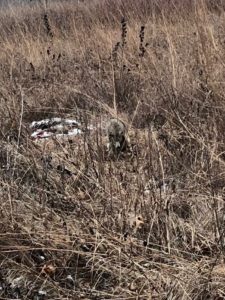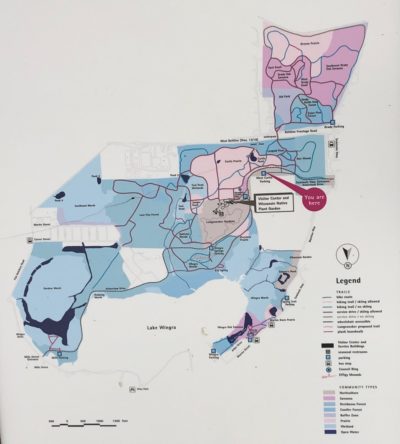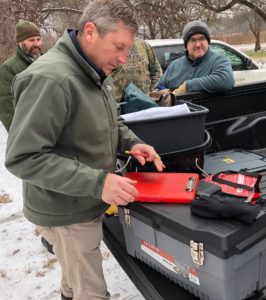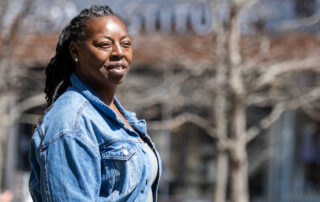Coyotes have moved into areas within the Madison city limits. What does that mean for human and canid coexistence? Researchers are trying to find out through the UW-Madison Urban Canid Project. Steve Gotcher joined the group of scientists in the field on a quest to capture and examine a coyote. Here’s what he found…
==
Steve Gotcher: Just after sunrise on a chilly late November morning, I’m among a group of UW Madison students as part of a study of coyotes in an urban environment. The goal is to understand how coyotes and humans coexist in the city. We’re hoping to catch a coyote in one of the locations around Madison’s West Side, find out about its overall health and fit the animal with a radio collar to study its movements throughout the town. The sparse snow cover crunches underfoot as our guide…

PhD student Sara Garza and UW-Madison Veterinary students examining a coyote. (Photo by Steve Tomasini)
Sara Julia Garza: “[I’m] Sara Julia Garza. I’m a PhD student assisting Dr. David Drake with the Urban Canid Project here in Madison, Wisconsin.”
SG: …leads the way down a path at the Lakeshore Nature Preserve.
SJG: “We’ve got a bait pile set out over here. By bait pile, I mean a deer carcass that somebody killed and it was on the side of the road. We’re going to walk single file so as to minimize our impact on the on the area. We’ll check the sites and, hopefully, catch something.”
SG: By examining a coyote up close, researchers will be able to study pack territoriality, movement patterns throughout the city, what their food sources are, any diseases they may be carrying, and…
SJG: “In this environment, I imagine people will be more concerned about the interactions of the urban canids and their own pets.”
SG: The trail snakes through the woods and then opens on a small meadow. Patches of crunchy snow dot the area with tufts of dead prairie grass swaying in the gentle breeze. A desiccated deer carcass lays in the center of the clearing with orange flags dotting the area marking where the traps are situated.

Captured coyote at UW Arboretum. (Photo by Steve Tomasini)
SJG: “It’s a cable or slip trap. It’s the same mechanism as a dog’s choke collar.”
SG: A quick search of the area reveals…
SJG: “We got some tracks. So, here we have our bait pile, and it looks like none of the traps has an animal in it, unfortunately.”
SG: We head back to the cars and make our way to the second site in the UW Arboretum just west of the Visitor’s Center in Curtis Prairie. A sea of tall grass rustles in the light breeze under the grey overcast. As the morning progresses the temperature slowly drops below freezing.
SJG: “We’ve got two sites here. It’s a similar setup as before with the cable restraints. One of them, I’m gonna ask you guys to kind of stay on the main path and away from it while I go check it out because we’re trying to minimize our impact on it. The other one is in a more heavily trafficked area, so we can all definitely take a look at the drop site.”

Map of UW Arboretum. (Photo by Steve Tomasini)
SG: A well-used hiking trail parallels the road leading to the Arboretum Visitor’s Center before it turns heading deeper into the prairie.
SJG: “Yesterday when we checked these traps we saw quite a lot of tracks indicating high activity, but nobody had gotten in the traps.”
SG: Just off the path, set back in the prairie grass, is the site we hope will hold a captured coyote.
SJG: “So we’re trying to catch two animals here in the Arboretum. Oh, so you can see it right here from the side. We got that flag right there and you can actually see the bait pile from here. Holy cow! We have an animal. Oh, my goodness. Okay. I’m texting Drake right now. All right. We’re going to back off…”
SG: Within 30 minutes veterinary students arrive on the scene along with lead researcher…
David Drake: “[I’m] David Drake, an extension wildlife specialist and professor in the Department of Forest and Wildlife Ecology and I’m what’s called the principal investigator for this project. We come in with a pull noose and we just slip the noose around the animal’s head to control it and to make sure that it can’t swing around and bite us as we inject a double sedative in the back leg. Once we get the sedative injected, we back off for about 10 minutes to let the sedative work and then we’ll go back and see how sedated the animal is. Once the animal is comfortably sedated we’ll go, and start processing the animal and work the animal up.”
SG: The sedated coyote is brought out from the trap site and placed on a tarp spread out on the trail. The animal is still somewhat awake so to keep it calm a towel is placed over its head.
DD: “We coordinate with the vet students, so that the students who are interested in perhaps, some aspect of wildlife vet medicine they get an opportunity and some experience handling wild animals. The vet students are just so much more adept at taking the health samples then we are so it’s a good experience for them and it’s tremendously helpful for us.”
SG: A small group of vet students around the young female Coyote on their hands and knees and the examination begins led by…
Emily Gregg: “[I’m] Emily Gregg. I’m one of the coordinators for the Urban Canid Project. We’re checking for fleas with this flea comb and we’re taking vitals; temperature, respiratory and heart rate. Also, we will be taking a nasal swab, a rectal swab and then a fecal sample as well.”
SG: When all the samples have been taken and the animal is weighed, ours was 31 pounds. It’s fitted with a radio collar and color-coded ear tags. The crew works quickly and efficiently, and the entire process takes just over 30 minutes to complete. After an injection is given to reverse the sedative the group packs up and heads to the parking lot. A couple of observers stay behind and watch as the animals slowly stirs, looks around, cautiously gets up and takes a few halting steps. Soon the effects of the sedative wear off and the young female is seen trotting down the trail into the prairie.
DD: “That collar is turned and starting at 9:00 tonight that collar will start to communicate with the satellites and for the rest of that collar’s life, for the rest that animal’s life we will get eight fixes a night on that animal to see where it’s going.”
SG: The UW Urban Canid Project is in its sixth year of research to find out more go to our Web site at WPR.org.
[The quotes have been edited for brevity and clarity.]

UW-Madison Urban Canid Project researchers. (Photo by Steve Tomasini)












